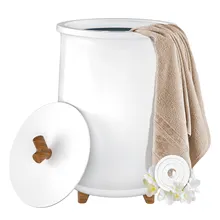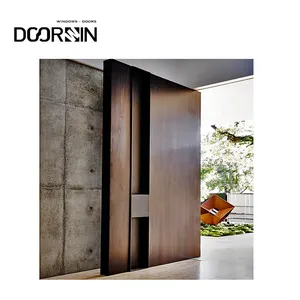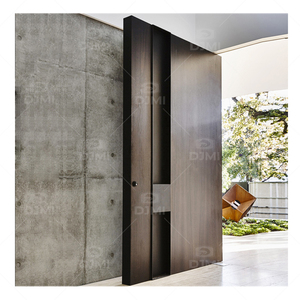Introduction
Welcome to our comprehensive buyer's guide on solid wood doors. This guide will explore the aesthetic appeal, the different types available, and the benefits they bring to your home or business. We'll delve into the unique characteristics of hardwood, softwood, and composite wood doors, and discuss how each type can enhance your living or working space. We'll also provide practical advice on choosing the right door for your needs, evaluating its quality, and maintaining it to ensure its longevity and beauty.
The Timeless Appeal of Solid Wood Doors
Embrace timeless elegance with our Antique Natural Wood Distressed French Door, a remarkable piece that brings an air of vintage elegance to your living space. Meticulously crafted with exceptional attention to detail, it embodies the timeless beauty and rustic allure that antique doors are renowned for. The distressed finish adds character, imparting a weathered look that exudes authenticity. Adorned with intricate detailing and ornate carvings, this door is a work of art in its own right. The masterful craftsmanship is evident in every curve and flourish, creating a captivating focal point that effortlessly draws attention.
Types of Solid Wood Doors
Businesses can choose from various types of wooden doors. Among these, we have battened and ledged doors, wooden Dutch doors, bifold doors, wooden French doors, panelled doors, laminated core flush doors, hollow-core doors, and wooden louvered doors. Each type has unique features and applications, making them suitable for different business needs. For instance, battened and ledged doors are excellent for external doors and narrow openings, while wooden Dutch doors offer a clear outside view and can act as a window. Bifold doors are perfect for rooms with spacious balconies or lobbies extending to outer decks.
Hardwood Doors
Hardwood doors, such as those made from mahogany, are a popular choice for front doors due to their durability and aesthetic versatility. These doors can be styled in a variety of ways, painted in any color, and even accommodate windows. They are known for their durability, able to withstand physical trauma, rain, wind, and more when properly maintained. Moreover, hardwood doors are extremely insulative, reducing energy bills by keeping heat and cold from entering your home. However, they require regular staining and finishing to maintain their condition and prevent warping.
Softwood Doors
Softwood doors offer a variety of unique characteristics. Douglas Fir, a large, vertical-grained tree from the Pacific Northwest, is known for its natural strength and durability, with a color varying from yellowish tan to light brown. Knotty Alder, another Pacific Northwest native, is a medium density hardwood with an even grain, usually light brown with hues of red or peach. Knotty Pine, abundant in America, displays a rich array of knots, reflecting the beauty of nature, with a honey-toned or straw color. Ponderosa Pine, one of America’s most abundant tree species, has a straight, uniform grain with honey-toned or straw-colored wide growth bands.
Composite Wood Doors
Composite wood doors are a superior choice for home security and insulation. They are crafted using a variety of materials and the latest technology, featuring an insulating foam core enclosed by a Glass Reinforced Plastic (GRP) skin. This design makes them resistant to weathering and virtually maintenance-free. They are strong, durable, and offer excellent thermal efficiency. Composite doors also provide noise reduction and come in a variety of design options, adding a striking appearance to your home.
Benefits of Solid Wood Doors
Solid wood doors add a richer look and feel to the home. They are made entirely out of wood, including the core, and can be stained or painted as desired. Given their strong structure, they are an excellent choice for a main entrance. Solid wood doors serve a functional purpose, but they also significantly affect the style of your space, bringing a level of elegance that is often missing.
Durability and Longevity
Solid wood doors have been a staple of luxury homes for centuries, offering a high-end look and feel that is unmatched. They are made from 100% solid wood, adding warmth, beauty, and character to any space. One of the main advantages of solid wood doors is their durability. Solid wood construction makes a door very strong and resistant to wear and tear, making them ideal for high-traffic areas. They are also great insulators, providing a natural barrier against heat, cold, and noise.
Aesthetic Appeal
Nobody can deny the visual effect one receives when walking up to a home with a beautiful wooden door. They have a warmer feel to them and elegantly accent almost any exterior design your home could have. Choosing a wooden door isn't as straightforward as you would think. If you want a more polished look, then you could go for bamboo or teak. Choose elegant with a traditional oak or the rustic vibe with a knotted pine wood. Customize them further by applying a stain or a finish.
Energy Efficiency
Solid wood doors are relatively efficient when it comes to energy conservation. They offer quality insulation and can have draft-proofing and sealing properties, which do not allow any warmth to escape. However, more modern alternatives such as solid core, vinyl, and even steel are superior in this regard. Despite not being as suitable as other doors designed specifically for energy efficiency, there are still ways you can adjust solid wood doors to improve energy efficiency, such as adding weather strips and door sweeps.
Sound Insulation
One of the significant benefits of solid wood doors is their sound insulation properties. Solid doors, due to their dense nature, are considerably heavier than hollow-core doors, which contributes to their superior soundproofing capabilities. It's worth noting that these doors may require hinges with longer, sturdier screws to support the weight. This feature makes solid wood doors an excellent choice for areas in your home where you desire privacy or noise reduction.
Choosing the Right Solid Wood Door for Your Home
Choosing the right solid wood door for your home involves several considerations. Firstly, test the weight of the door. Solid doors are usually much heavier than hollow core doors. Secondly, examine the finish on the door. If it's stained and heavy, it's likely to be solid-core. Thirdly, inspect the panelling. Solid wood doors have detailed, real panels. Lastly, consider the door's condition and price. Solid wooden doors are durable and resist wear and tear, but they are pricier due to their quality construction.
Consider the Door's Purpose
When considering the purpose of your door, it's important to understand the different functions available. For instance, 'Passage' doors, typically used for interior doors, don't require locking. 'Privacy' doors, ideal for bathrooms, can be locked from the inside. 'Patio' doors, used for patio entrances, can also be locked from the inside, providing no access from the outside. 'Dummy' doors are non-operating, used for aesthetic balance. 'Single Cylinder' and 'Double Cylinder' functions are used for deadbolt locks, with the latter providing no free egress. Choose the function that best suits your door's purpose.
Match the Door with Your Home's Style
Matching your solid wood door with your home's architectural style can enhance the aesthetic appeal and harmony of your living space. Whether you own a Victorian home with scalloped wood sidings or a colonial design where symmetry is key, the right door can complement these unique features. For instance, a solid wood door showcasing natural wood color and texture can be a perfect fit for a ranch style home. Remember, there's room for creativity alongside design theory when choosing your door. The goal is to find a door that not only matches but also enhances your home's style.
Evaluate the Door's Quality
To evaluate the quality of a solid wood door, check the material and the door's core. Quality material should not produce an unpleasant odor, and the frame should be level without visible dents or scratches. During quality control, veneer doors are inspected for knots or rot sections. Other materials used during construction, such as the glue and stains, must also meet certain standards of quality. A quality veneer door should keep swinging for years and resist warping. You can also check the package integrity, looking for opened or torn packaging, and examine the heat and sound insulation.
Maintenance and Care for Solid Wood Doors
Maintaining solid wood doors involves regular cleaning and periodic sealing or painting. Weekly dusting and monthly thorough cleaning help maintain the door's aesthetic appeal. Use a non-abrasive brush or soft cloth with mild soap for cleaning. Avoid using harsh materials that can scratch the wood. Seasonal polishing keeps the door gleaming, while refinishing every few years addresses signs of serious wear. Care for the door's hardware, including doorknobs and fixtures, is also essential. If the door has glass, keep it clean. Check and replace damaged weatherstripping to maintain energy efficiency.
Regular Cleaning
Wood doors require occasional maintenance to ensure their longevity and appearance. Both exterior and interior doors need their own level of care. Exterior doors, exposed to weather and touch, should be cleaned periodically. Interior doors, frequently touched and attracting dust, also require regular cleaning. With these cleaning tips, your wood doors will not only look great but last for you too.
Periodic Sealing or Painting
Maintaining the elegance of solid wood doors involves periodic sealing or painting. This not only enhances the door's aesthetic appeal but also protects it from weather and potential rot. Start by cleaning the door, removing any grime or mildew. Next, tape off areas you don't want to paint. Apply a heavy-duty primer, which offers excellent adhesion and mildew resistance. Once the primer is dry, apply at least two coats of high-quality exterior paint. This process seals, protects, and 'dresses up' your solid wood door, ensuring its longevity.
Addressing Damages Promptly
Solid wood doors, while durable, can sustain damage over time. Minor scratches can be treated with wood filler and light sanding. For holes, small ones can be filled with a wooden dowel and wood glue, while larger or irregular holes can be filled with epoxy wood filler. After the filler hardens, use spackle on the patch and scrape it flat with a putty knife. Once dry, prime and paint the patch to create a uniform look. Addressing damages promptly ensures the longevity and aesthetic appeal of your solid wood door.
Conclusion
In conclusion, solid wood doors offer a timeless elegance that can enhance any space. Their durability, aesthetic appeal, energy efficiency, and sound insulation properties make them a superior choice for homes and businesses alike. Choosing the right door involves considering its purpose, matching it with your home's style, and evaluating its quality. Once installed, regular cleaning, periodic sealing or painting, and prompt damage repair will ensure your door's longevity and continued beauty. Whether you're renovating an old home or building a new one, a solid wood door can add a touch of luxury and character that is truly timeless.









































 浙公网安备 33010002000092号
浙公网安备 33010002000092号 浙B2-20120091-4
浙B2-20120091-4